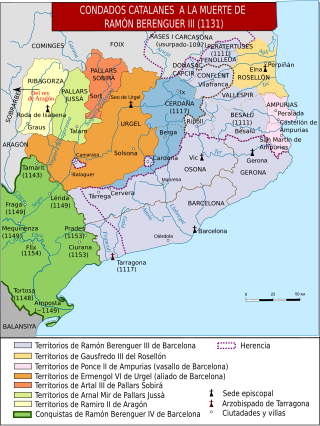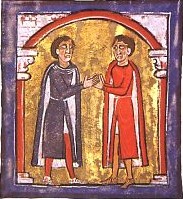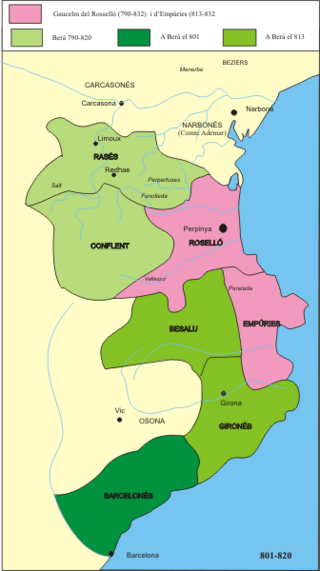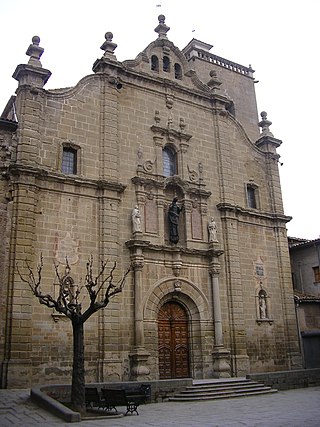
La Seu d'Urgell is a town located in the Catalan Pyrenees in Spain. La Seu d'Urgell is also the capital of the comarca Alt Urgell, head of the judicial district of la Seu d'Urgell and the seat of the Bishop of Urgell, one of the co-princes of Andorra. It is located in the district of Alt Pirineu i Aran and is the most populated town, with 17.4% of the district's population. La Seu d'Urgell and Puigcerdà together have 30% of the population of the area.

The County of Urgell is one of the historical Catalan counties, bordering on the counties of Pallars and Cerdanya.

The Diocese of Urgell is a diocese in Catalonia (Spain) and Andorra in the historical County of Urgell, with origins in the fifth century AD or possibly earlier. It is based in the region of the historical Catalan County of Urgell, though it has different borders. The seat and Cathedral of the bishop are situated in la Seu d'Urgell town. The state of Andorra is a part of this diocese.
Galindo Aznárez I was Count of Aragón from 844 to 867.

Berenguer Ramon I [Berengar Raymond I], called the Crooked or the Hunchback, was the count of Barcelona, Girona, and Ausona from 1018 to his death.

Ramon Borrell was count of Barcelona, Girona and Ausona from 992. He was the son of Borrell II of Barcelona and Letgarda of Rouergue, and was associated with his father in ruling the counties from 988.

The abbey of Saint-Michel-de-Cuxa is a Benedictine abbey located in the territory of the commune of Codalet, in the Pyrénées-Orientales département, in southwestern France. It was founded initially in 840, and then refounded at its present site in 878, after a flood destroyed the original buildings. It was an important cultural centre in the regency of Abbot Oliba.

Font-Romeu-Odeillo-Via, or simply Odeillo, is a commune in the Pyrénées-Orientales and Cerdagne near the Spanish border in the south of France. It comprises the villages of Odeillo and Via, as well as Font-Romeu, one of the oldest ski resorts in France and the oldest in the Pyrenees.

Wifred or Wilfred was the Count of Cerdanya and Count of Berga. He was the eldest son of Oliba Cabreta and Ermengard of Empúries.
The County of Cerdanya was one of the Catalan counties formed in the last decades of the 8th century by the Franks in the Marca Hispanica. The original Cerdanya consisted of the valley of the upper Segre. Today Cerdanya is a Catalan comarca.

Ermengol or Armengol VI, called el de Castilla, was the Count of Urgell from 1102 until his death. He was the son and successor of Ermengol V and María Pérez, daughter of Count Pedro Ansúrez, Lord of Valladolid, who became the young Ermengol's tutor when he was orphaned in 1102.

ErmengolIII, called el de Barbastro, was the count of Urgell from 1038 to his death. He was the son of Ermengol II, Count of Urgell and his wife Velasquita "Constance", probably the daughter of Bernard I, Count of Besalú.

Ermengol or Armengol II, called the Pilgrim, was the Count of Urgell from 1011 to his death. He was the son of Ermengol I, Count of Urgell and his second wife, Guisla. Still a child when he succeeded his father, who was killed in battle against the Moors, he was put under the regency of his uncle Ramon Borrell, Count of Barcelona until 1018.

The County of Conflent or Confluent was one of the Catalan counties of the Marca Hispanica in the ninth century. Usually associated with the County of Cerdanya and the county of Razès, it was located to the west of Roussillon. It largely corresponded to the modern comarca of Conflent.
Sal·la was the Bishop of Urgell from 981 to 1010, and "one of the first Catalan figures whose own words" survive sufficiently "to give colour to his personality and actions", although all of the words attributed to him were written down by scribes. He receives mention in some sixty-three surviving contemporary documents. As bishop, Sal·la dated documents by the reign of Hugh the Great. Although his episcopate largely preceded the Peace of God movement in Catalonia, his excommunication of high-ranking public figures during a church–state dispute in 991 anticipated it. He also pioneered feudal practices such as the granting of fiefs and was frequently "ahead of the feudalising wave".

Guissona is a town and municipality located in the north of the comarca (county) of Segarra, in the province of Lleida, Catalonia, Spain. With 6,862 inhabitants Guissona is the principal municipality in the northern half of Segarra and the second most populated in the county after Cervera. In addition to the populated place of Guissona, the municipality integrates the smaller place of Guarda-si-venes. The municipality is split into two parts, the bigger eastern part containing almost all the population.

Teresa d'Entença was the eldest daughter of Gombau d'Entença and his wife Constança d'Antillón. She was Countess of Urgell in her own right; however, control over her estate passed to her husband, Alfonso IV of Aragon.
Wilfred or Wifred, called the Hairy, was Count of Urgell, Cerdanya, Barcelona, Girona, Besalú and Ausona. On his death in 897, his son, Wilfred Borrell, inherited these Catalan counties.

Sancha Ramírez was an Aragonese princess, the daughter of King Ramiro I and Queen Ermesinda. She was the countess of Urgell from c.1063 until 1065 as the wife of Count Ermengol III. Her brothers Sancho Ramírez and García Ramírez became king of Aragon and bishop of Pamplona, respectively. During her brother's reign she played an important role in consolidating the Kingdom of Aragon, which had been founded by her father in 1035.
















